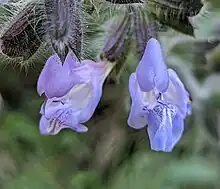Salvia recognita
Salvia recognita is a woody-based perennial that is endemic to central Turkey, typically growing in light shade at the base of cliffs, at elevations of less than 4,000 feet (1,200 m). It contains a low concentration of salvinorin A, at approximately 213 micrograms per gram of plant material.[1]
| Salvia recognita | |
|---|---|
 | |
| Scientific classification | |
| Kingdom: | Plantae |
| Clade: | Tracheophytes |
| Clade: | Angiosperms |
| Clade: | Eudicots |
| Clade: | Asterids |
| Order: | Lamiales |
| Family: | Lamiaceae |
| Genus: | Salvia |
| Species: | S. recognita |
| Binomial name | |
| Salvia recognita Fisch. & Meyer | |
A mass of divided leaves forms a small to medium basal clump, with leaves ranging in size from 3-4 inches to nearly 1 foot long, with three or more leaflets. The light green leaves are covered with thick hairs, giving it a grayish cast and thick texture, with each leaf blade having a wine-colored petiole. The flowers are cyclamen-pink, growing in whorls, with calyces that are covered in glands and hairs. The flower stalks reach 2–3 feet long, with many whorls of widely spaced flowers.[2]
Notes
- Hatipoglu, Seda Damla; Yalcinkaya, Burhanettin; Akgoz, Muslum; Ozturk, Turan; Goren, Ahmet C.; Topcu, Gulacti (1 November 2017). "Screening of Hallucinogenic Compounds and Genomic Characterisation of 40 Anatolian Salvia Species: Hallucinogenic Compounds and Genomic Analysis of Salvia Species". Phytochemical Analysis. 28 (6): 541–549. doi:10.1002/pca.2703. PMID 28722248.
- Clebsch, Betsy; Barner, Carol D. (2003). The New Book of Salvias. Timber Press. p. 237. ISBN 978-0-88192-560-9.